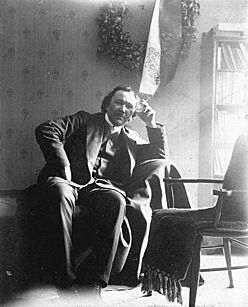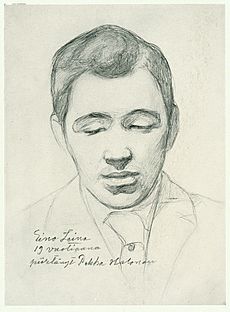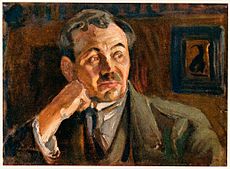Eino Leino facts for kids
Quick facts for kids
Eino Leino
|
|
|---|---|

Eino Leino in 1912
|
|
| Born |
Armas Einar Leopold Lönnbohm
6 July 1878 Paltaniemi, Paltamo, Finland
|
| Died | 10 January 1926 (aged 47) Tuusula, Finland
|
Eino Leino (born Armas Einar Leopold Lönnbohm; 6 July 1878 – 10 January 1926) was a famous poet and journalist from Finland. He is known as one of the first and most important Finnish poets. Many people consider him a national poet of Finland.
Leino's poems mix modern ideas with old Finnish folk stories. Much of his writing is like the Kalevala, which is Finland's national epic, and traditional folk songs. He often wrote about nature, love, and feelings of sadness. Even today, Eino Leino is very popular and widely read in Finland. His birthday, July 6, is called Eino Leino Day. It is a special day for Finnish poetry and summer, and a day when the Finnish flag is flown.
Contents
Eino Leino's Early Life
Eino Leino was born Armas Einar Leopold Lönnbohm in Paltamo. He was the seventh and youngest son in a family with ten children. His family lived in the Hövelö house in Paltaniemi village. Eino's older brother, Kasimir Leino, was also an important cultural figure. He was a poet, a critic, and a theatre director. Eino and Kasimir started a literature magazine together in 1898.
Eino Leino showed his talent for writing very early. He published his first poem when he was just 12 years old. By the time he was 18, he had already released a collection of poems called Maaliskuun lauluja.
Leino's parents passed away while he was still in school. He began his schooling in Kajaani and later studied in Oulu and Hämeenlinna. After finishing secondary school in Hämeenlinna, Leino went on to study at the University of Helsinki.
Eino Leino's Writing Career

When Eino Leino first started his writing career, critics loved and praised his work. He became part of important literary and newspaper groups. He also joined a group called the Young Finnish circle. Among Leino's close friends were the artist Pekka Halonen and Otto Manninen, who became famous as a poet and translator.
During a difficult time in Finland, leading up to the Finnish Civil War, Eino Leino spoke out. He warned in a magazine that the country was close to a civil war. He felt very strongly about the situation. Leino had always written about tolerance and understanding. He also respected the labor movement and had good friends there.
Leino experienced the events of spring 1918 in Helsinki. He wrote about his experiences in a book called The Conquest of Helsinki (1918). He hoped for peace and understanding among everyone in Finland. In April 1918, he wrote a series of articles called "For the Finnish Workers." In these articles, he strongly asked for peace and for people to understand each other. He believed that everyone should follow the ideals of fairness, democracy, and freedom.
After the Finnish Civil War, Leino felt sad that the country was not as united as he had hoped. His influence as a journalist became weaker. In 1918, when he was 40, he was given a special pension from the State for his writing. Even though he kept writing many books, he faced money problems and his health got worse. He once wrote to his friend, "Life is always a struggle with eternal forces."
Leino published more than 70 books of poems and stories. His most famous works are two poem collections called Helkavirsiä (1903 and 1916). In these books, he used a lot of ideas from Finnish mythology and Finnish folklore.

Besides writing poetry, Eino Leino also wrote for newspapers. He wrote about theatre and culture. He also translated books by important writers like Runeberg and Goethe. He was the first person in Finland to translate Dante's famous book, the Divine Comedy, into Finnish.
In the summer of 1921, Leino traveled to Estonia for a writing tour. He gave poetry readings and presentations in Tartu and Tallinn. The trip was a great success, and people welcomed him as an important poet. After his trip, he married for the third time, to Hanna Laitinen. However, this marriage ended quickly. In 1921, Leino even asked to give up his Finnish citizenship. He wrote to the presidents of Finland and Estonia, asking to become an Estonian citizen. He was tired of not getting enough support and of the criticism he received.
Leino was married three times and had one daughter named Helka. He passed away in 1926 at the age of 47. He was buried in the Hietaniemi Cemetery in Helsinki. Because he was so famous, the state paid for his funeral. The President of Finland, L. K. Relander, and other important leaders attended.
A detailed story of Leino's life was written in the 1930s by his friend and fellow writer, L. Onerva.
Leino's Literary Style and Importance
Eino Leino is seen as the first and most important person to shape a style called "national romanticism" in Finnish literature. He even created the term national neoromantism. He used it to describe the works of talented Finnish artists like the composer Jean Sibelius, the painter Akseli Gallen-Kallela, and the architect Eliel Saarinen.
Leino's writing style changed over his 35-year career. In his early works, including his most famous collection Helkavirsiä (1903), you can see the influence of the Finnish national epic, the Kalevala.

In the middle of his career, Leino translated classic books from around the world into Finnish. At the same time, he wrote his own works in many different styles. These included poems, plays, essays, reviews, and other newspaper articles. His writing showed a wide range of feelings, from deep love to strong criticism.
In his last years, after facing difficulties in his personal life, Leino returned to the national romantic themes he wrote about when he was younger.
See also
 In Spanish: Eino Leino para niños
In Spanish: Eino Leino para niños
- The Eino Leino Prize
- The Eino Leino Statue
- Johan Ludvig Runeberg
- Poet and Muse


